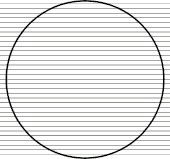Hello,
This is a personal project I am working on. This is not homework in any form or fashion. I am attempting to calculate a theoretical maximum of objects that can fit within a perfect Sphere. The only thing that I can find that is even remotely close is the calculation for determining how many perfect Circles can fit within a larger perfect circle:
My specific problem is this: How many 3 meter tall, 0.5 meter radius Cylinders can fit within a 50 meter radius Sphere?
On a cursory calculation, the Sphere has a volume of 523,599.7756 meters cubed, and the Cylinder has a volume of 2.3562 meters cubed, and simple division leads to (a little surprising and humorous) 222,222 Cylinders fitting within the sphere.
The problem I am running into is the Cylinders need to maintain their own unique shape, so a Packing Ratio is required to account for this. How would I even begin to approach this calculation to get closer to an answer?
And, as a side question, the Circles-within-a-Circle calculation accounts for margin of error due to different packing methods with the final ±1% in the equation. What would be the margin of error for a calculation of this nature?
This is a personal project I am working on. This is not homework in any form or fashion. I am attempting to calculate a theoretical maximum of objects that can fit within a perfect Sphere. The only thing that I can find that is even remotely close is the calculation for determining how many perfect Circles can fit within a larger perfect circle:
(Larger Radius / Smaller Radius) ^ 2 x .9069 ± 1%.My specific problem is this: How many 3 meter tall, 0.5 meter radius Cylinders can fit within a 50 meter radius Sphere?
On a cursory calculation, the Sphere has a volume of 523,599.7756 meters cubed, and the Cylinder has a volume of 2.3562 meters cubed, and simple division leads to (a little surprising and humorous) 222,222 Cylinders fitting within the sphere.
The problem I am running into is the Cylinders need to maintain their own unique shape, so a Packing Ratio is required to account for this. How would I even begin to approach this calculation to get closer to an answer?
And, as a side question, the Circles-within-a-Circle calculation accounts for margin of error due to different packing methods with the final ±1% in the equation. What would be the margin of error for a calculation of this nature?

